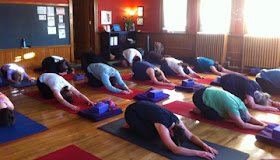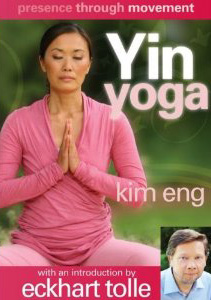Exercise 1: Finding Mula Bandha (pelvic floor engagement) and Uddiyana Bandha (lower abdomen engagement)
Setting up:
Start by laying on your back on the floor with your knees bent (Constructive Pose). Find a neutral pelvis - hip points and top of pubic bone are on the same plane. Do a couple of pelvic tilts and tucks to find neutral. Use extra padding (folded blankets) as needed under the bum or under the neck/head for comfort.
Find a regular, steady breath. Notice how the inhale causes the respiratory diaphragm to press down into the organs which in turn press down into the pelvic floor (this is subtle - don't worry if you can't feel it yet). The exhale returns the respiratory diaphragm to its resting "umbrella-like" position under the rib cage.
Working in the pose:
After establishing your breath, begin to exaggerate the movement of the belly and pelvic floor. On your inhale, relax everything and let the belly rise. On your exhale, pull your belly toward your spine without moving your actual spine - keep your pelvis neutral. Now you are engaging the transverse abdominus and Uddiyana Bandha. Inhale and soften again. Take a few rounds of this breath. Inhaling and relaxing, exhaling and engaging.
Adding on, we will start to find the pelvic floor muscles. On your exhale I want you to engage the pelvic floor muscles (these are the muscles between the tailbone and pubic bone and from sit bone to sit bone) and the belly muscles (transverse abdominus). Pull the pelvic floor muscles up toward the area behind your belly button and pull your lower belly back toward the spine. Don't worry if you can't figure this out at first. It takes practice. On the inhale, relax everything again. Take a few rounds of this type of breathing. Inhale and relax, exhale and engage belly and pelvic floor.
If you can imagine your muscular engagement as a dial, practice your engagement at different levels of engagement. Try about a 3, then dial it up to a 7; try a 10 (completely engaged) then dial your engagement back to a 1 or a 2. Practice these different levels to become familiar with the amount of effort it takes to engage. Why? Because you don't need to dial up your engagement to a 10 if you are only picking up a water bottle. But what if you are picking up a toddler or a heavy rock? Then you need more muscular engagement.
Finishing:
Let yourself completely relax after working Mula Bandha and Uddiyana Bandha. Take any finishing movements that you like: a long stretch, a bundle roll hug, gentle twist, etc.
Benefits of Pelvic floor work:
Helps reverse or prevent incontinence; Can assist in reversing or preventing prolapse; Improves sexual functioning; Improves your fluid movement and connection with your inner core.
Benefits of Pelvic girdle work:
Creates stability in the pelvis; Reduces back pain; Reduces SI pain; Creates a center that is unshakeable; Improves posture and stability from the inside out.
Previously: My Story Part IV: Restoring my Inner Core
Up next: More exercises to improve your core.
ps - Just 5 minutes a day of these exercises can help you. You don't even have to lay down and take time out of your day (although you should give yourself a break). You can practice your inner core engagement while you are sitting at your desk, waiting for a stop light, doing dishes, or any time you think of it.



























